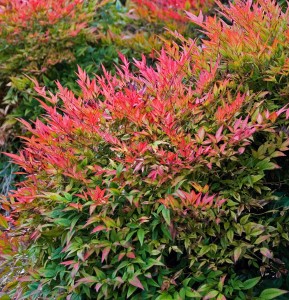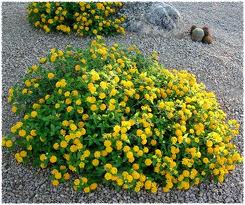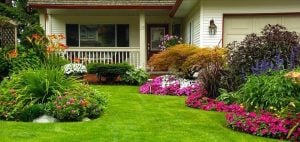Planting the right plants for your yard design can elevate a drab space into an inviting area to spend time outdoors, but how do you know what to look for when shopping for plants? Good design is all about the careful selection of plants and the arrangement of these plants to create an inviting and natural place. An easy way to get started with developing your landscape design is by seeking advice from a local landscape dealer like Premier Nursery!
Introducing Common Landscape Plants
Choosing the right plants is one of the most critical steps in landscape design. Not only do they need to be the right size and shape for your space, but they also must be suited to your climate and soil type. With so many factors to consider, it can be overwhelming to choose the perfect plants for your home. To help you out, we’ve put together a list of common landscape plants that are sure to look great in any yard.
 Nandina: When it comes to adding that perfect touch to your home landscape design, nandina is an excellent choice. This hardy plant is easy to care for and can withstand various climates. Nandina best grows in zones 6 through 9 and is coveted for its lack of maintenance needs. Nandina is known for living despite lack of care, even thriving on abandoned properties! Also known as “heavenly bamboo,” nandina is deer resistant and best used as a screening shrub or container gardening. Here are a few tips on shopping for the best Nandina plants to complete your home landscape design:
Nandina: When it comes to adding that perfect touch to your home landscape design, nandina is an excellent choice. This hardy plant is easy to care for and can withstand various climates. Nandina best grows in zones 6 through 9 and is coveted for its lack of maintenance needs. Nandina is known for living despite lack of care, even thriving on abandoned properties! Also known as “heavenly bamboo,” nandina is deer resistant and best used as a screening shrub or container gardening. Here are a few tips on shopping for the best Nandina plants to complete your home landscape design:
- Look for a plant that is dense and compact. Avoid plants that are leggy or have sparse foliage.
- Choose a plant that is a deep green color. Avoid plants that are yellow or have any other off-shade colors.
- Select a disease-resistant plant. You don’t want your beautiful nandina to be susceptible to diseases that could potentially kill the plant.
- Make sure the plant you choose is appropriate for the climate in which you live. Nandina can tolerate both hot and cold weather, but make sure the plant you select can handle the specific climate conditions in your area.
- Once you’ve found the perfect Nandina plant for your home landscape design, give it plenty of room to grow. This hardy plant can reach up to six feet tall, so make sure you have enough space
 Lantana: Lantana is a beautiful and versatile flowering plant perfect for adding a splash of color to your home landscape design. However, you should know a few things about this plant to ensure you get the best possible plants for your needs.
Lantana: Lantana is a beautiful and versatile flowering plant perfect for adding a splash of color to your home landscape design. However, you should know a few things about this plant to ensure you get the best possible plants for your needs.
Lantana is a tropical plant, so it thrives in warm climates. However, if you live in an area with cooler winters, you’ll need to bring your lantana plants indoors or purchase ones specifically bred to be winter hardy.
When shopping for lantana plants, look for ones with healthy green leaves and plenty of buds. Avoid plants with yellow leaves that seem wilted, as these may not recover well.
Once you bring your lantana plants home, give them a good drink of water, and then place them in a sunny spot. Lantana likes full sun but can tolerate some light shade. Monitor your lantana plants closely for the first few weeks after planting, as they may need extra water to get established.
Your lantana plants will thrive with proper care and provide months of colorful blooms.
 Hydrangea: Another popular choice, hydrangeas add a touch of color to any landscape with their large blossoms that come in shades of pink, blue, and purple. They’re perfect for adding some extra interest to your garden beds or along walkways.
Hydrangea: Another popular choice, hydrangeas add a touch of color to any landscape with their large blossoms that come in shades of pink, blue, and purple. They’re perfect for adding some extra interest to your garden beds or along walkways.
Indian Hawthorn: Indian Hawthorn is perfect for smaller gardens and areas around house foundations. These are low maintenance and grow to heights and widths of between three and six feet.
Indian Hawthorns produce beautiful white or pink blooms in the spring that are pleasantly fragrant, which later change to blueberries that steadily feed wildlife. These grow best in hardiness zones between 8 and 11. Because of that, Indian Hawthorns do not tolerate freezing temperatures well at all.
Hosta: Looking for a hardy, low-maintenance plant to add to your home landscape? Hostas are a great option! Here are some tips on shopping for the best hostas to complete your home landscape design:
- Consider the size of the plant. Hostas come in various sizes, from miniature varieties that only grow to be a few inches tall to giant varieties that can reach up to six feet. Choose a size that will fit nicely into your landscape design.
- Consider the color of the leaves. Hostas come in many colors, from traditional green to variegated shades of green and white. Choose a color that you think will complement your other plants and landscaping features.
- Consider the amount of sun or shade the plant will need. Most hostas do best in shady areas, but some varieties can tolerate more sun. Know how much sun or shade your landscape receives before choosing a hosta variety.
- Ask questions! If you’re unsure which hosta variety suits you, don’t hesitate to ask the nursery staff for help. They can offer guidance and advice based on your specific needs and landscape.
Understanding the Importance of Good Landscapes
 When landscaping your home, it is vital to understand the difference between good and bad landscapes. Good landscapes are pleasing to the eye and can add value to your home. Bad landscapes, on the other hand, can be an eyesore and may actually decrease the value of your home. As such, it is crucial to take the time to learn about landscaping and understand what makes a landscape excellent or bad. By doing so, you will be able to choose the best plants for your home landscape design and create a space that you and your family can enjoy for years to come.
When landscaping your home, it is vital to understand the difference between good and bad landscapes. Good landscapes are pleasing to the eye and can add value to your home. Bad landscapes, on the other hand, can be an eyesore and may actually decrease the value of your home. As such, it is crucial to take the time to learn about landscaping and understand what makes a landscape excellent or bad. By doing so, you will be able to choose the best plants for your home landscape design and create a space that you and your family can enjoy for years to come.
A few Tips when Shopping for Plants
When it comes to shopping for plants, there are a few things you need to keep in mind to find the best ones for your home landscape design. Here are a few tips:
- Know what kind of climate and soil conditions you have. This will help you narrow down your choices and find plants that are better suited for your area.
- Consider the mature size of the plant. You don’t want a plant that will outgrow its space, so choose one that will fit nicely into your landscape design.
- Take into account the amount of care and maintenance required. Some plants require more care than others, so be realistic about how much time and effort you’re willing to put in.
- Don’t forget about color! Make sure to choose plants that complement the other colors in your landscape design.
- Think about texture. Consider the leaves and the flowers when choosing plants, as different textures can add interest and depth to your landscape design.
By following these tips, you’ll be sure to find the best plants for your home landscape design.
The Additional Plants Needed in Your Home Landscape Design
Like most people, you probably have a vision for your perfect home landscape. But what happens when you get out into your yard and realize that you’re missing a few essential plants? Here are a few tips on shopping for the best plants to complete your home landscape design:
- Decide what kind of atmosphere you’re going for. Are you looking for a formal garden or something more relaxed? This will help narrow down your plant choices.
- Consider the climate. Not all plants will do well in every environment. Make sure to choose plants that will thrive in your conditions.
- Get to know your soil. Different plants prefer different types of soil. Understanding the composition of your soil will help you choose plants that will be able to take root and flourish.
- Have a plan. It’s important to know exactly what spot you want each plant to go to before you start shopping. This way, you can get the right size and type of plant for each location.
- Don’t forget about maintenance. Some plants require more care than others. Be sure to factor in how much time and effort you’re willing to put into keeping.
When you need landscaping advice, help, or services, call or contact Premier Nursery!

